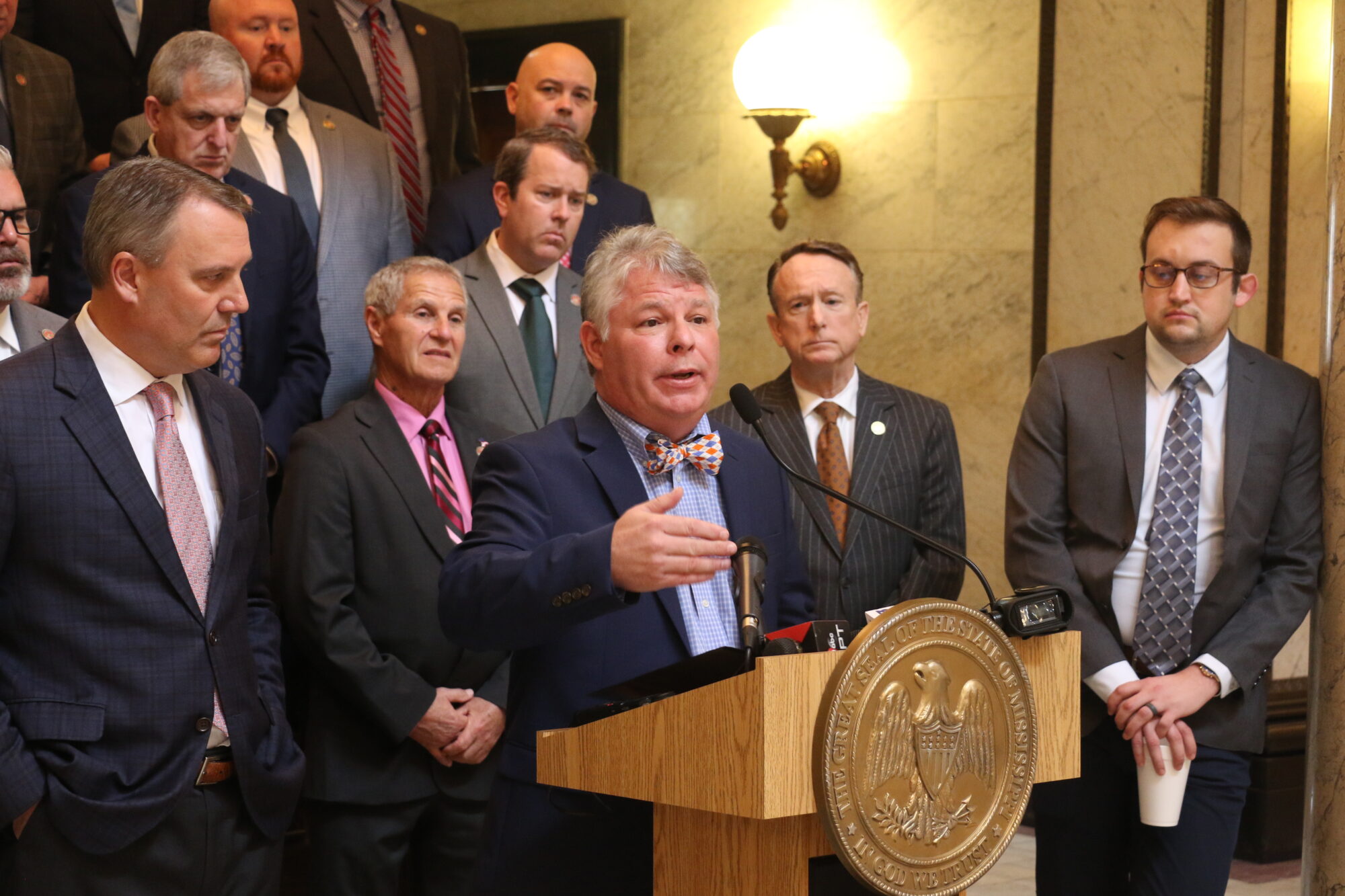
Rep. Rob Roberson addresses the media during a press conference held Thursday about the passage of the INSPIRE Act, a piece of legislation that aims to replace the current MAEP education funding model to provide more education funding in Mississippi. (Photo by Jeremy Pittari | Magnolia Tribune)
- House Education Chairman Roberson cautions school districts that saw a significant increase in funding to use it wisely.
Starting July 1, a new funding formula went into effect for Mississippi’s K-12 public education system. Some school districts will receive millions in additional funding under the new formula that replaces the former Mississippi Adequate Education Program, or MAEP.
The idea for the new funding structure, called the Mississippi Student Funding Formula, was to ensure that the school districts in most need received additional monies.
The increased local district allocations outlined below range from thousands to more than $18 million and include increases to educational funding as well as increases to teacher pay, health insurance and state retirement contributions in PERS.
Total increased funding statewide comes to just under $240 million.
“The purpose of this is to help the districts that do not have a tax base,” State Representative Rob Roberson (R) explained to Magnolia Tribune. “To suggest that the intent was to raise money for areas that already have a tax base would be wasteful spending. So, the whole point of this is to make certain that we are getting to areas that do not have a tax base, getting them more in line where they need to be.”
Roberson chairs the Education Committee in the Mississippi House of Representatives.
The top five districts receiving the most in increases include Jackson Public School District at $18.3 million, Desoto County Schools at $15.8 million, Jones County School District at $8 million, Lamar County School District at $7.9 million and Picayune School District at $5.8 million.
Districts that will see lesser increases include Coffeeville School District with $26,120, West Tallahatchie School District at $32,056, South Delta School District at $33,838, Baldwyn School District at $38,586, Quitman County School District at $42,158 and North Bolivar Consolidated School District at $42,741.
“The long-term effect of this is to make sure we are educating kids, not necessarily to continue raising the amount of money we’re spending on education just because,” Rep. Roberson described. “We’re raising it in places that need it.”
Rep. Roberson explained that the reason behind the Jackson Public School District receiving a larger increase than all other districts is because the capital city has seen a major decrease in population, which has also impacted the district.
The U.S. Census Bureau reports that between the 2010 and 2020 census, Jackson lost roughly 20,000 residents. Another 10,000 decrease was estimated between 2020 and 2023.
“When you have an area that has a depleted tax base you have to fill the gap somehow, and Jackson would be one of those places that has lost a tremendous amount of population,” Roberson elaborated. “So, the reality is that Jackson would be one more example of a place that we have to spend some money to get their educational system back up.”
Similar significant reduction in population in certain areas across the state lends itself to the potential for consolidation between districts, the House Education Chairman added.
Roberson cautions districts that saw a significant increase in funding to use it wisely.
“Just because we did this this year doesn’t mean that we’re not going to look for solutions for Jackson or anywhere else,” Rep. Roberson said. “I would not put a tremendous amount of faith in the fact that just because you got an increase this year doesn’t mean that you don’t have to make sure you’re spending it properly in the upcoming years.”
Forest Thigpen, Senior Advisor with Empower Mississippi, agrees that monitoring the extra money is wise, ensuring the dollars are reaching the intended demographics.

“Because how the money is spent, not the amount of money available to spend, is the key to the effective use of all spending,” Thigpen said.
As previously reported, the new funding formula has a weighted system that focuses on poverty levels, special education needs, sparsity in population and other factors.
READ MORE: New education funding formula signed into law, MAEP no more
One of the notable weights in the new system addresses children categorized as living in poverty. Those students may not have the same opportunities due to living in single parent homes or homes where the parents have a limited education.
For instance, MAEP previously provided a 5 percent weight for low-income students. Under the new formula, a low-income student will draw a 30 percent weight, good for an additional $2,008 on top of the base student cost, which is $6,695 in the first year. The base student funding will be increased in 2026, 2027, 2028 based on inflation. Beginning in 2029, and once every four years thereafter, the State Board of Education will recommend a new base student funding amount based on a new “objective formula” that factors in instructional, administrative and facility costs.
Thigpen said some ways to spend the dollars wisely in the low-income category could be through extra tutoring, more training for new teachers, and teacher retention and recruitment. He said those factors are especially true in rural school districts, many of which fit into the poverty category.
“Right or wrong, the school has to spend more to make up for those challenges the students face,” Thigpen added.
With Mississippi mostly categorized as a rural state, Thigpen believes it could be hard to attract teachers to a district where they have to drive further to get to work each day while also dealing with the extra demands that might be placed on teachers in districts classified as rural or with a high poverty level.
Another important weight the new formula aims to address is in workforce development through the enticement of more Career and Technical Education (CTE) courses.
“I have been surprised to learn how relatively few districts provide CTE courses, so this (weight) is intended from a financial standpoint to encourage more CTE training,” Thigpen described. “And plus, a lot of the CTE classes require equipment or tools or other things that cost more than the curriculum of an academic class.”
The new funding formula does include a hold harmless provision for three years, meaning funding for school districts will not decrease from what they received in the 2023-2024 school year.
Rep. Roberson was clear that the hold harmless provision is for a school district’s planning purposes, allowing local school leaders time to make cuts where and if needed before the provision expires. He added that the previous funding formula through MAEP also had a hold harmless provision that lasted for decades. However, this one will not be in place that long.
“The original MAEP formula had districts that were held harmless for 20-some-odd years. That is not what we’re doing,” Roberson said. “This hold harmless is intended to give school districts the ability to plan. We will be sticking to a three-year plan.”
Compared to the traditional public schools in the state, charter schools saw much smaller increases in funding. The charter school that saw the largest increase was Clarksdale Collegiate at $681,817, while the district with the smallest increase was Instant Impact Global Prep at $594.
Rep. Roberson explained that charter schools did not receive as much of an increase due to the way the weighted formula works.










